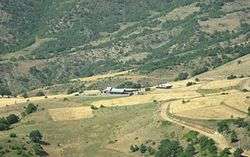Setan
| Setan ستن | |
|---|---|
| village | |
|
Village view in June 2011 | |
 Setan | |
| Coordinates: 38°59′19″N 46°44′21″E / 38.98861°N 46.73917°ECoordinates: 38°59′19″N 46°44′21″E / 38.98861°N 46.73917°E | |
| Country |
|
| Province | East Azerbaijan |
| County | Khoda Afarin |
| Bakhsh | Minjavan |
| Rural District | Minjavan-e Gharbi |
| Population (2006) | |
| • Total | 236 |
| Time zone | IRST (UTC+3:30) |
| • Summer (DST) | IRDT (UTC+4:30) |
Setan (Persian: ستن; also known as Sūtanī and Syutany)[1] is a village in Minjavan-e Gharbi Rural District, Minjavan District, Khoda Afarin County, East Azerbaijan Province, Iran. At the 2006 census, its population was 236, in 58 families.[2] This is a significant drop as compared to the population of the village in early 1960s, which was 340.[3] Still, the decline is moderate as previously more prosperous villages of Arasbaran region, such as Abbasabad, experienced on average fourfold reduction in their population and some nearby villages were abandoned.
In the wake of White Revolution (early 1960s) a clan of Mohammad Khanlu tribe, comprising 120 households, used Setan and Masjedlu as their winter quarters.[4] The affiliation, however, could not be ethnic as people of Setan are followers of Yarsan religion. A prominent spiritual figure of the religion, Zal Soltan Navazi, lived in Setan. One of his sons Rostam Navazi is a relatively well known poet.
References
- ↑ Setan can be found at GEOnet Names Server, at this link, by opening the Advanced Search box, entering "-3086519" in the "Unique Feature Id" form, and clicking on "Search Database".
- ↑ "Census of the Islamic Republic of Iran, 1385 (2006)". Islamic Republic of Iran. Archived from the original (Excel) on 2011-11-11.
- ↑ http://www.loghatnaameh.org/dehkhodaworddetail-cf2c2f56c6ef4a44a9b7533bf8b0d11e-fa.html
- ↑ P. Oberling, “The Tribes of Qarāca Dāġ,” Oriens 17, 1964, p. 69
